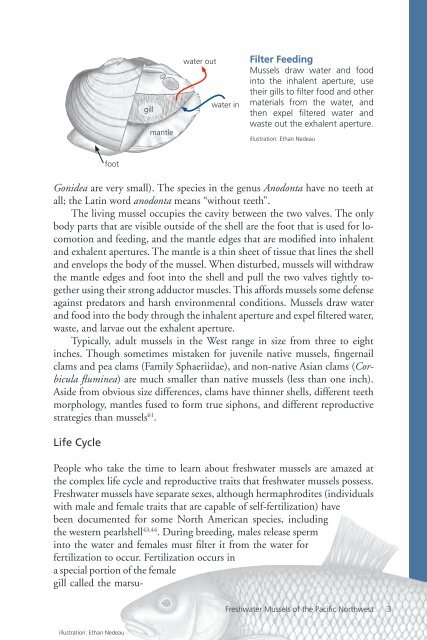Freshwater Mussels Pacific Northwest - The Xerces Society
Freshwater Mussels Pacific Northwest - The Xerces Society
Freshwater Mussels Pacific Northwest - The Xerces Society
Create successful ePaper yourself
Turn your PDF publications into a flip-book with our unique Google optimized e-Paper software.
foot<br />
illustration: Ethan Nedeau<br />
gill<br />
mantle<br />
water out<br />
water in<br />
Filter Feeding<br />
<strong>Mussels</strong> draw water and food<br />
into the inhalent aperture, use<br />
their gills to filter food and other<br />
materials from the water, and<br />
then expel filtered water and<br />
waste out the exhalent aperture.<br />
illustration: Ethan Nedeau<br />
Gonidea are very small). <strong>The</strong> species in the genus Anodonta have no teeth at<br />
all; the Latin word anodonta means “without teeth”.<br />
<strong>The</strong> living mussel occupies the cavity between the two valves. <strong>The</strong> only<br />
body parts that are visible outside of the shell are the foot that is used for locomotion<br />
and feeding, and the mantle edges that are modified into inhalent<br />
and exhalent apertures. <strong>The</strong> mantle is a thin sheet of tissue that lines the shell<br />
and envelops the body of the mussel. When disturbed, mussels will withdraw<br />
the mantle edges and foot into the shell and pull the two valves tightly together<br />
using their strong adductor muscles. This affords mussels some defense<br />
against predators and harsh environmental conditions. <strong>Mussels</strong> draw water<br />
and food into the body through the inhalent aperture and expel filtered water,<br />
waste, and larvae out the exhalent aperture.<br />
Typically, adult mussels in the West range in size from three to eight<br />
inches. Though sometimes mistaken for juvenile native mussels, fingernail<br />
clams and pea clams (Family Sphaeriidae), and non-native Asian clams (Corbicula<br />
fluminea) are much smaller than native mussels (less than one inch).<br />
Aside from obvious size differences, clams have thinner shells, different teeth<br />
morphology, mantles fused to form true siphons, and different reproductive<br />
strategies than mussels 61 .<br />
Life Cycle<br />
People who take the time to learn about freshwater mussels are amazed at<br />
the complex life cycle and reproductive traits that freshwater mussels possess.<br />
<strong>Freshwater</strong> mussels have separate sexes, although hermaphrodites (individuals<br />
with male and female traits that are capable of self-fertilization) have<br />
been documented for some North American species, including<br />
the western pearlshell 43,44 . During breeding, males release sperm<br />
into the water and females must filter it from the water for<br />
fertilization to occur. Fertilization occurs in<br />
a special portion of the female<br />
gill called the marsu-<br />
<strong>Freshwater</strong> <strong>Mussels</strong> of the <strong>Pacific</strong> <strong>Northwest</strong> 3

















